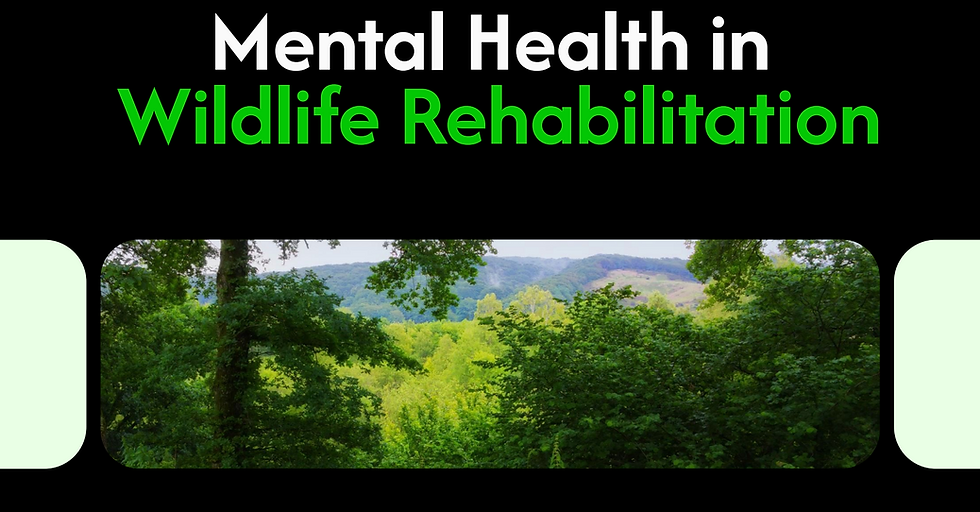WReNNZ Minimum Standards – The Pros and Cons
- WReNNZ

- Aug 16, 2023
- 3 min read

Wildlife rehabilitation is the rescuing, treating and releasing of injured, sick or orphaned wild animals back to their natural habitats. It is a challenging and rewarding activity that requires specialised skills, knowledge and facilities. However, not all wildlife rehabilitators follow the same protocols or standards when caring for their patients. This can lead to inconsistent outcomes, ethical dilemmas and potential harm to the animals and the environment.
Having a minimum standard of care when rehabilitating wildlife is essential and beneficial for the animals and the people involved. A minimum standard of care is a set of guidelines or criteria defining the acceptable quality and performance level in wildlife rehabilitation. It covers aspects such as animal welfare, veterinary care, housing, nutrition, hygiene, record keeping, release criteria and post-release monitoring.
Would we accept a healthcare system that did not have a minimum standard across the country?
In this article, we will explore the pros and cons of having a minimum standard of care when rehabilitating wildlife.
Some of the pros of having a minimum standard of care when rehabilitating wildlife are:
- The primary advantage of having a minimum standard of care when rehabilitating wildlife is that it ensures the animals receive proper care and attention that meets their physical, behavioural and psychological needs.
- It reduces the risk of disease transmission, injury, stress and suffering for the animals and the rehabilitators.
- Proper medical attention, nutrition, and living conditions can significantly improve the overall health of animals. By having a minimum standard of care, rehabilitators can ensure that the animals are in optimal health before they are released.
- It increases the chances of successful release and survival of the animals in the wild. This is especially important for endangered species whose populations are already at risk.
- Setting a minimum standard of care for wildlife rehabilitation promotes professionalism in the field. It ensures that all rehabilitators follow best practices and provide high-quality care for the animals. It creates a sense of accountability and credibility among wildlife rehabilitators and fosters collaboration and communication with other stakeholders such as veterinarians, wildlife authorities, researchers and the public.
- It contributes to the conservation of biodiversity and the protection of ecosystem health by preventing or minimising negative impacts on native wildlife populations and habitats.
Some of the cons are:
- It can be difficult to define and apply a universal minimum standard of care that suits all species, situations and contexts, as different animals may have different needs and preferences.
- It can be costly and resource-intensive to implement and maintain a minimum standard of care, especially for small or remote rehabilitation centres that may lack funding, staff, equipment or facilities. However, the increased costs are necessary to provide the best care for the animals.
- It can create ethical dilemmas or conflicts when deciding whether to accept, treat or euthanise an animal that does not meet the minimum standard of care or when balancing the needs of individual animals versus populations or ecosystems.
- Adhering to a minimum standard of care can be time-consuming. It requires extra effort to ensure that all protocols are followed correctly. However, the time invested is worth it as it ensures that the animals receive the best possible care.
- It can discourage or exclude some potential or existing wildlife rehabilitators who may feel intimidated, overwhelmed or restricted by the minimum standard of care.
WReNNZ believes the pros of having a minimum standard of care when rehabilitating wildlife far outweigh the cons. It ensures that animals receive the best possible care, increasing their chances of survival and improving their health. It also promotes professionalism in the field and creates accountability. While it may require extra resources and time, the benefits are crucial for the well-being of the animals, and that should be what all wildlife rehabilitators should be working toward. Remember, it is not about us as rehabbers – it is about the wildlife we treat!
Minimum standards are there to act as a framework to build best practices and to help guide rehabbers in the needs and capacities of each situation. Rather than fearing minimum standards, rehabbers should embrace them in the best interests of our wildlife.
This article was written by
Brian Robertson
WReNNZ Chairperson






Comments